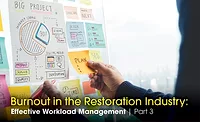Burnout in the Restoration Industry: Managing Workload | Part 2

Editor’s Note:
This is the second article of a multi-part series on employee burnout in the restoration industry. Part one introduced the nature of burnout, and summarized findings from a study on burnout in the restoration industry. Part two begins a discussion on things restoration companies can do to manage one of the most complicating factors for burnout among restoration professionals - workload. Part three advances the conversation and discusses what restoration professionals can do at the individual level to manage workloads more effectively.
Nature of Workload for Restoration Companies
The nature of our industry has inherent demands and fluctuations that seem challenging to control. At any given point, a variety of circumstances from a catastrophic weather event to the loss of a staff member can have a dramatic effect on the workload of the company and the team members. It is safe to say that a career in restoration is not a 9 to 5, 40-hour per week job; however, in consideration of the findings of the burnout study, there is much to be gained by proactively managing the workloads of our team, our most valuable assets.
When we consider workload, we can look at it from two related perspectives: organizational and individual. Can solutions be found by balancing volume and capacity at both levels? In part one of this series, we will delve into some potential solutions that allow us to control volume and capacity at the company level followed by the second part, which will examine the balance at the individual level. It should be noted that these concepts are not exclusive to each other, but rather are inter-related strategies that can be considered in our efforts to reduce workload.
As we consider taking control of volume and capacity in our companies, there are added benefits of a few sound principles that apply to the effective management of our day to day operations. While avoiding the epidemic of burnout from affecting your team, we may be able to improve in our service to others and find sound economics and financial benefits.

Volume of Work
It may seem counterintuitive to control or decrease the volume of work coming into your company. You have strategized, invested, and have put great energy into having the phone ring and then we want to decrease it? At any given point, when your volume is exceeding your capacity, not only are we exposing the team to the threat of burnout, there is a risk of detrimental side effects to your reputation, customers, and quality of your services.
When do you know that it is time to dial it down in an industry where you could be inundated one week and waiting for the phone to ring the next week? There is not necessarily an exact science to this but rather an understanding of your capacity combined with intuition and being in tune with your team and organization.
In Eastern Pennsylvania, what started out as a steady summer, turned into an unrelenting series of individual localized flood events that continually moved around targeting and retargeting a localized area. The first of the flood events to wreak havoc presented itself in early July. The team worked diligently around the clock until everyone was taken care of in some way. Then another flood, and another flood, and another flood, with nothing but weather forecasts, there was no way to tell that the weather would cause extremely high volumes for over two months straight. After several weeks, it was time to dial it down for the good of the team and the quality of the services being delivered. There is no crystal ball in our business; therefore, we must be able and willing to pivot at any given point.
When volume is exceeding capacity, the following are a few strategies that may help control and reduce workload:
- Managing Expectations:
- Evaluate and prepare to communicate realistic timelines that allow you a more manageable volume as a company.
- Be honest and upfront to those you serve and make commitments based on reasonable workloads. Example: “Normally we are able to respond to emergencies within an hour. However, due to the high volumes of disasters in our region, we are scheduling emergency responses two days out.” If you are managing repair/reconstruction volume, give accurate and upfront timelines for repairs to begin.
- Be prepared to help those who reach out to you. Refer other restoration companies who may be able to help sooner and/or give tips on how they can mitigate until you can respond.
- Pausing / Controlling Streams:
- Many in our industry have a variety of relationships and strategies that bring revenues to the organization. As an effort to control workload, the following is a sample of potential sources that can be temporarily paused or reduced:
- Insurance programs: direct and TPA (third-party administrators)
- Lead generation and referral programs
- On-line initiatives and advertising
- Other preferred vendor lists
- Territory/Coverage Area:
- The territory or area of coverage that your company covers may be something to evaluate when attempting to dial down the volume. Depending on circumstances and geography, reducing coverage area (even slightly) can have a reduction in volume that has an exponential effect on workload. As an example, if there are areas that you serve that require a 90 to 120-minute drive per day, you can potentially buy back three to four hours in drive time with a minimal effect on total revenues. At times, there may be good economics to this approach as drive distance can also have an effect on job profitability.
Company Capacity
When we consider capacity, we are literally looking at the amount we can produce with our resources. Our resources can include but are not limited to human, equipment, vehicles, and facility. Depending on the timing, both internal and external forces can influence capacity. As we look at the environment today, unemployment is at a historic low, and this could be directly affecting your company’s capacity by making it challenging to hire and add to the team. During the polar vortex of 2014, due to the widespread effects of severely cold temperatures, equipment and supply inventories were affected.
In general, to be able to adjust and control capacity we need solid systems and operations in place that allow us to know what resources are available at any given moment. Consider that you have depleted your equipment inventory, perhaps you rented additional equipment and that is also depleted, one may plan and schedule based on the timing of equipment being pulled and available by using systems and tracking.
Our team also influences capacity as it applies to the human resources within our organization. By employing a similar approach in scheduling and managing our equipment, we must also add the leaderships’ empathy and intuitiveness for the team. The individuals who make up your team may have a vast array of skills, proficiencies, individual training, and circumstances that may also contribute to your overall company capacity.

As we consider some possible solutions to increasing your capacity as a company with a focus on our human resources, it can decrease the workloads on the individual team members. In addition, there is sound economics to some of the considerations that apply when operating at any given volume level.
Expanding Capacity
The following strategies may be helpful when trying to expand capacity to reduce the workload on the individuals within the company:
- Improve Efficiency:
- Examine and find ways to decrease the workload by improving efficiencies.
- Duplication of efforts
- Employing technology when possible
- Routing and movements in our field operations
- “The way we always did it.” Be mindful of activity within workflows that may have little or no value to the organization and eliminate it.
- Within the workflows there may be opportunities to reassign tasks to better utilize the individual’s special skills and improve their workload while increasing the capacity of the organization.
- Expand your Resources:
- Other Restoration Companies: Either referring other restoration companies or developing relationships to work together.
- Subcontractors: Utilize your existing subcontractors and aggressively build new relationships.
- Other Sources of Labor:
- Employment agencies may be able to supply a variety of labor and support for your team. They may also be a resource to manage the HR and processing of seasonal and other type of employment opportunities that could help the team.
- Be creative. For example, if there are local colleges in your area, you may be able to recruit college students to help monitoring water losses and other tasks which may prove to give some relief to your team on weekends and after hours. The college students could be run through the employment agency for your ease of management.
- Specialty Resources: From accounting to estimating, there are a variety of specialty services, some that are even industry specific, that may be utilized at any given point in managing capacity.
- Develop and Train:
- Proficiency: Encourage and develop individual’s proficiency in their skills.
- Organization Skills: Including but not limited to email management, time management, etc.
- Leadership and Soft Skills: Imagine a great technician who was trained and developed in their leadership and management abilities. This technician can run a loss with two less experienced individuals allowing the opportunity to increase capacity.
- Cross Train: Cross training individuals within the organization not only gives team members the opportunity to increase their value to the company; it also allows the company to be nimbler when managing fluctuations in volumes.
Process and Structure
An overarching imperative to being able to proactively manage volume and capacity is having strong day to day processes and structure. Strategic scheduling, workflows, procedures, and best practices provide the ability to have information and structure to pivot and adjust these as needed.
At any given time, we can adjust volume and capacity to help us manage workload. Managing the company workload will help the individual team members enjoy the reward of being a part of the restoration industry and avoid burnout.
Looking for a reprint of this article?
From high-res PDFs to custom plaques, order your copy today!







